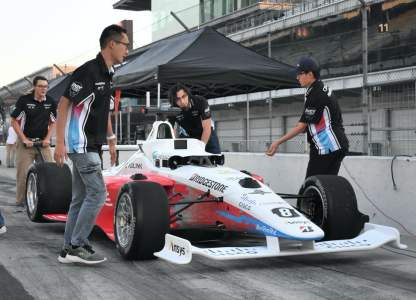
Waterloo students to race autonomous vehicles at Indy speedway
Maryam Farag
Industry Automotive automotive engineering manufacturing mechanical race race cars Software Students University of Waterloo Waterloo
Waterloo students Brian Mao (front left) and Ben Zhang (front right) work with teammates during testing of their autonomous car at the Indy speedway. Photo: University of Waterloo.
Two students at the University of Waterloo helped develop an autonomous, million-dollar race car that drives itself around the Indianapolis Motor Speedway at speeds of up to 120 miles per hour.
Brian Mao and Ben Zhang are members of a four-university team set to compete with rivals from around the world for a US$1-million top prize at the Indy Autonomous Challenge on Saturday.
“This is something nobody else has done before – take autonomous vehicles up to those kinds of speeds,” said Mao, a master’s student in applied mathematics. “There are a lot of unsolved problems that have to be tackled.”
Ten teams representing 21 universities will put modified Dallara AV-21 race cars through their paces at Indy. Students from nine countries have been working since 2019 to program driverless cars equipped with the latest sensory equipment so they are capable of negotiating the track on their own at high speeds. Waterloo is the sole Canadian school involved.
Mao, 23, of Newmarket and Zhang, 24, of Vancouver will be part of a six-person pit crew for their car when the final race is staged. It was one of just four that didn’t crash in the final simulated race in June.
“The only control we have is an emergency button,” said Zhang, a master’s student in electrical and computer engineering.
“Honestly, it’s amazing just seeing it in person,” said Mao of the stadium. “The track is so big that after the first turn, we won’t even be able to see our car. We have to watch it on several monitors.”
Waterloo initially had a team of its own called WATORACE, but joined forces with the Massachusetts Institute of Technology, the University of Pittsburgh and the Rochester Institute of Technology to pool resources and expertise due to the complexity of the project.
